Congratulations!
Your screen print shop is successful – and you’re one of the small percentage of entrepreneurs that make it to the hiring phase of running a business.
But how should you hire, how should you train them, and how can you make it easier?
Here are some powerful resources to help you organize and systematize your hiring and onboarding process.
How to use this guide
Overall, we suggest:
- Using a general first week schedule for all new employees
- Using a first week checklist for all new employees
- Having department-specific 30-day goals list
- Investing heavily up front in onboarding and training
Guide to Hiring for Print Shops
Project-based hiring is how to hire great employees for your screen printing business.
Hiring is hard.
It’s a real gray area – every person is different! You are gambling on whether they’ll be a good fit for your business. You’ll never feel 100% certain that a new hire is right for your shop.
But you can take 4 simple steps to standardize hiring practices in your shop.
Your hiring process can be as simple or complex as you’d like, but standard processes and questions for hiring are how to get the most value out of your time. Standard questions and activities arm you with actionable data that lets you make better comparisons and decisions about who to hire.
Look, it’s impossible to perfectly, fairly, and accurately compare two people. But a standardized process ensures you can make the best possible comparison between potential employees.
Why and how to implement hiring standards
There is no 100% accurate way to compare two different people for the same job.
Why standards matter:
With no hiring standards and no process, you’re making a guess when you hire a new employee. But to grow your business, or even just improve it, you need A-grade employees…particularly in management.
At Printavo, we’ve had a lot of success hiring because we’ve spent a lot of time and resources on hiring. The main insight I can offer is that our hiring got a lot better after we created a specific persona for each role within Printavo.
How to implement hiring standards:
Creating hiring standards isn’t actually that challenging. You would simply match each employee’s role in your shop to a specific persona.
Each role (quality control, press operator, screen room hero, sales, production management, and so on) has a slightly different persona that is most likely to succeed. Sales people are outgoing, press operators are detail-oriented, production managers are highly organized, screen room workers are typically tough and willing to get dirty.
So how do you determine a person’s persona in an interview?
The fastest way to determine what kind of persona a candidate has is to use project-based hiring practices.
But first, you have to take a step back and work on your business to understand who can succeed in your shop.
Step 0: Your Values
Step zero?! Yes – before you begin interviewing, you have to actually create standards. But how do you create standards?
You define your business’ values.
I’ve written elsewhere about developing values for your business, but I’ll give you the steps to take:
- Think carefully about your values
- Ask: how would I want to be treated by a business?
- Ask: what are the three major areas I can focus on?
- Example: at Printavo, we believe in Community, Product, and Support. We strive for patience, iteration, and ongoing education in everything we do.
- Choose your values
- Find ways to measure your values
- Pick no more than three major areas to focus on
- Example: at my shop, we believe in Fast Turnaround, Low Spoilage Rates, and 100% Reponse Rate. We strive for collaboration, openness, and clean, high-quality products.
- Write down your values
- Write a brief sentence that encapsulates your values
- Example: at Printavo, we believe we can help print shops get organized and grow their business.
- Example: at my shop, we believe we can help our customers get great products to promote their mission.
Don’t skip this step! It’s crucial. You won’t know who to hire if you’re not sure who you are as a business owner!
Values define who should work in your business, narrowing the candidates that might be a good fit.
Some candidates will not align with your values – and that’s ok. That’s what we want! The core values in your screen printing shop exist to simplify your operations and hiring practices around your biggest and most important goals. Shops with great culture and long-lasting employees are very vocal about their values!
Step 1: The Phone Interview (30 minutes)
Will this person fit in with your team? With you? With your business values? With this specific role?
A 15 to 30-minute phone interview filters out of a lot of poor candidates right off the bat. But you have to do it in a structured, consistent manner to be able to compare candidates.
After you’ve defined your overall values, think about the values for the role you’re interviewing.
A production manager is likely curious, organized, a leader, and consistent.
A press operator is likely athletic, detail-oriented, and comfortable following directions.
A screen room worker could be self-motivated, detail-oriented, and happy to be part of a team rather than a leader.
Develop a set of traits that each role would have. Then, think about questions that could test those traits. A quality control worker needs to be patient, for instance – so test their patience with repeated questions.
The primary goal for a phone interview is to prove that the candidate aligns with the values for the role they’re interviewing for. Enter into phone interviews with the expectation that the person won’t work out, and let their answers illustrate whether they align with the values or not. This is the time to say No early and say No often.
Note: it’s not unusual to interview dozens of candidates through phone screens. Don’t be discouraged.
Step 2: The Standard Interview (1 to 3 hours)
If the candidate passes the phone interview, seems like a good fit, and you’re interested in proceeding – bring them into the shop for an in-person interview.
One of the simplest ways to gauge someone’s comfort with screen printing is to take them on a tour of your shop.
Can they keep up? Do they seem interested? Some candidates may never have been in a screen printing shop and could be immediately turned off – others will focus in on something that interests them, reveal how much they do or don’t know, or even ask lots of questions about the process.
Here are issues to tackle during the in-person interview – and questions that you can ask to get a feel for the person:
- Working experiences
- What do you like most about your current job?
- What has been a challenge you’ve faced in your work?
- What was your best boss like? Your worst boss?
- Tell me a story about your working experiences that made you feel fulfilled.
- Goals, interests, hobbies
- What are you passionate about?
- What do you dislike?
- Ideally, where would you like to be in 3 to 5 years at our shop?
- Tell me about your favorite hobby.
- Screen printing and your business
- What do you like about screen printing?
- What do you know about our shop?
- What would you like to learn about screen printing?
- Tell me a story about your favorite printed t-shirt.
- Personality and problem solving
- What do you appreciate about yourself?
- What do you wish you were better at?
- What makes you happy?
- How would you solve a problem in our shop if you weren’t sure who to ask or how to get help?
- Tell me about a time you went above and beyond what was expected of you.
Each question here gives you ample opportunity to get a read on the candidate. You can quickly discover red flags, test whether they are truly interested in your shop (versus just getting a paycheck). You may even discover interesting skills, hidden talents, or community connections they have which could help your business.
It’s vital that you don’t sugar coat life in a screen printing shop, particularly for candidates that don’t have experience in the industry. Be up front about expectations.
Accurate, fair, extensive job descriptions are another high-value activity for any shop owner – they set expectations and clarify exactly what’s expected.
Step 3: The Project – Task-Based Hiring (1 hour)
If the interview goes well, quickly assign a brief task-based project to the candidate after the interview. Set a clear due date, with a concrete deliverable for them to give you. This can happen in your shop or outside of it, depending on the role you’re hiring for.
Here are some examples of different projects you could assign to different roles in your screen printing shop:
- Production manager
- Assign around 30 jobs and see how they would schedule them
- Using Legos, “build” the ideal print shop workflow
- Ask how they would improve your current setup, or if any inefficiencies are present
- How would you lead a stubborn employee that doesn’t want to do things your way?
- Create a process for checking screen tension every time a screen is reclaimed
- A team member no-call no-shows. What do you do?
- Ask: What would you do in the first 90 days in your job, based on what you see here?
- Press operator
- Set up and break down a job on press
- Troubleshoot registration or tension issues
- Image screens in the darkroom (a great press operator will understand the screen making process)
- Explain the screen printing process in as much detail as possible
- Have them explain why a job should or shouldn’t be printed a certain way
- Screen room (coating, imaging, reclaim)
- Reclaim several screens
- Tape screens
- Burn screens
- Troubleshoot an imaging problem
- Break down a job
- Explain the imaging process in as much detail as possible
- Ask them to develop a plan to keep the screen room as clean as possible: how would they do it?
- Sales and marketing
- Do a mock sales call
- Feed them a “Secret Shopper” and see how they react
- Ask them to make several email templates
- Ask them how they would handle an angry customer
- Ask them to research the best possible clients for your shop
- Customer service representatives
- Mock interaction with an upset customer
- Mock interaction with a confused customer
- Mock interaction with a customer that isn’t a good fit, or is just price shopping
- Ask them to develop a better Quote Approval system
- Have them write email templates for different customer profiles
- Artists
- Assign a recent job to the artist and see how it compares to what you actually printed
- If they have a screen printing background, ask them to do a simple separation or vector trace
- If they don’t have a screen printing background, ask them to do research and report back
- Task them with developing an Art Approval process
- Ask them to explain the screen printing process in as much detail as possible
Projects are a powerful way to understand how a person works, whether they’re focused on the right issues, and (at a more basic level) whether the person is capable of and willing to go above and beyond.
Step 4: Feedback, Questions, The Offer
It’s not enough to assign a candidate a project and evaluate them based on their work. If you really want this activity to be valuable, you’ll call them back for a final interview. Ask for their help in critiquing the project, and work through it together.
Ask them to justify why and how they arrived at their finished project. They should have justification for almost everything they’ve done, and clear reasoning for making the choices they’ve made.
This is where the rubber meets the road and you fully determine whether the person is a good fit for the role or not. Some candidates may not even complete the assignment, others will do poor work, and some will put in truly stellar efforts.
Carefully consider:
- How well did you actually work with this person?
- Did their communication style mesh with yours?
- Were they combative and defensive about their work, were they apologetic, or were they (ideally) open to criticism and self-reflection?
- Is this the right persona for the role?
- Were there any red flags during the process?
- Did your team like this person?
Compare how different candidates performed. It’s unlikely you’ll have one perfect candidate. Ultimately, go with the candidate that best fits the role.
Even with standardized hiring practices in your screen printing shop, you have to take a leap of faith. Hire for talent and personality, train for skill and process.
Guide to Onboarding For Print Shops
The First Week
Hiring is much more than a job offer – it’s the entire process of training your new hire, too. Since there’s a labor shortage in the custom printing industry, keeping employees on once they’re hired is an essential skill.
The way to get there is with clear expectations and a solid schedule.
Building a Training Outline
One of the simplest ways to make onboarding easy is to provide a clear list of goals for the candidate.
For example, if you’re hiring an artist, after the first 30 days you might expect them to be able to:
- Sketch designs.
- Understand priority and importance of work.
- Updates Quote/Invoice Accurately
- Understands Underbase: Chokes Underbase Plate Correctly
- Understands Mesh Counts
- Understands Adobe / Corel / Other Design Software
- Separates for Simulated Process
- Can Color Correct Photoshop File
- Handles Art Approvals
- Comfortable Calling Customer About Art
- Has Style / Good Portfolio
We’ll break down more 30 day goals below.
First Week Checklist
We suggest creating a checklist for yourself and for the new hire with high-level goals for their first week.
The first week at a print shop should be custom-tailored to the new hire.
Great onboarding improves employee retention.
A new hire should understand the ins and outs of the business so that they can, potentially, fit into any role. Alternatively: focus specifically on the role they’ve been hired for with a carefully structured action plan.
This checklist helps guide and score a new hire’s progress through the first week.
Use it in tandem with the First Week Schedule below to help plan a new hire’s first week on the job. Customize it to fit your business – for instance, adding notes, images, or new elements that align with how you want your business to feel for a new hire.
First Week Schedule
The first week on the job sets the tempo and standards.
Your new hire is “drinking from the firehose” for the first week, so keep your schedule loose.
The goals for your new hire are simple:
- Get acclimated at the company.
- Shadow and train.
- Understand what they should do during their first week.
Goals for New Print Shop Employees: 30 Day Checklists
The first week is pivotal.
But the first 30 days are where the employee gets traction and begins understanding their role and their tasks.
We suggest using 30 days as your timeline because it’s long enough for major issues and questions to arise, but short enough that it’s easy to break down: it’s really the first 3 weeks after an employee’s initial onboarding.
To use these checklists, assign the following scores for each task with the employee at the end of their 30 day period:
- 3 is proficient and professional.
- 2 is good, but needs improvement.
- 1 is subpar.
- 0 is incomplete.
If an employee is trending below 70% completion in the first 30 days, it’s time to reconsider whether they’re a good fit in your shop.
All Employees
This checklist is a general outline for all employees. Aim for 100% completion.
Department-specific checklists
Need help hiring and training?
Need help with hiring, training, operations, or even marketing?
Printavo offers professional services to get your shop on the right track.
Email us at success@printavo.com and we’ll be in touch with how we can help your business rise to the top.
A huge thanks to the legendary Marshall Atkinson for inspiring this guide. Check out Marshall on the web here.
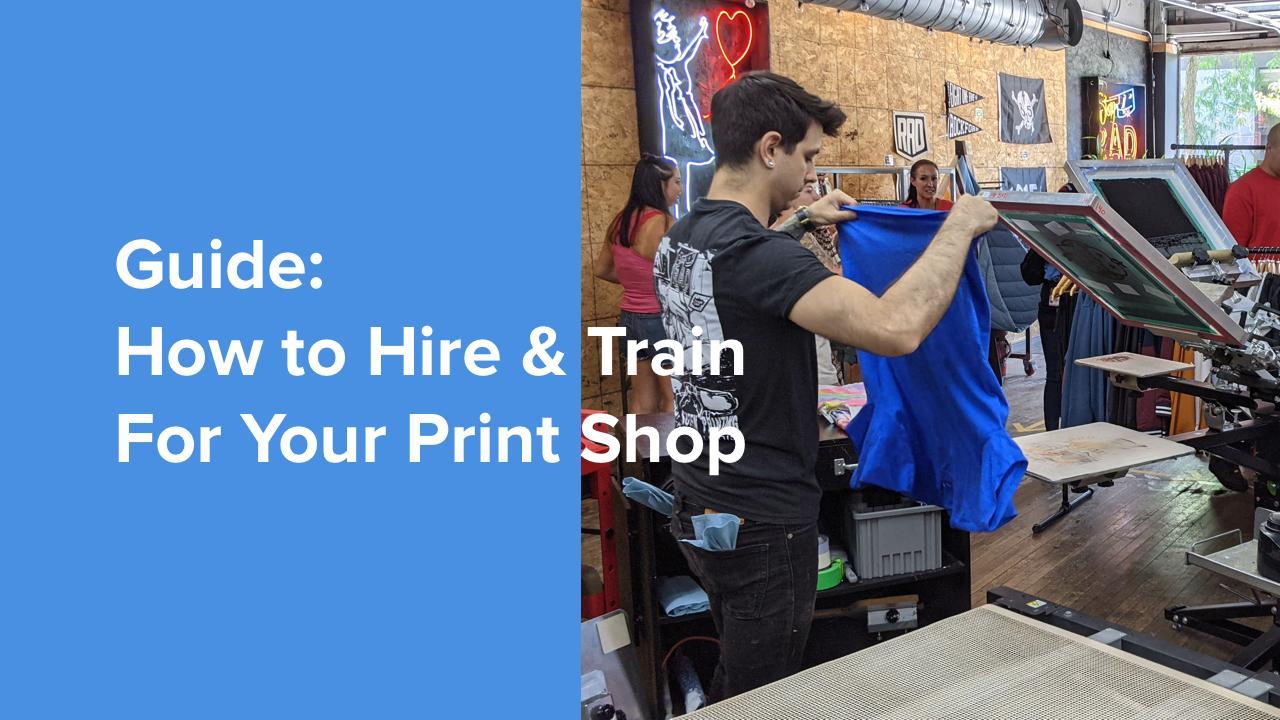
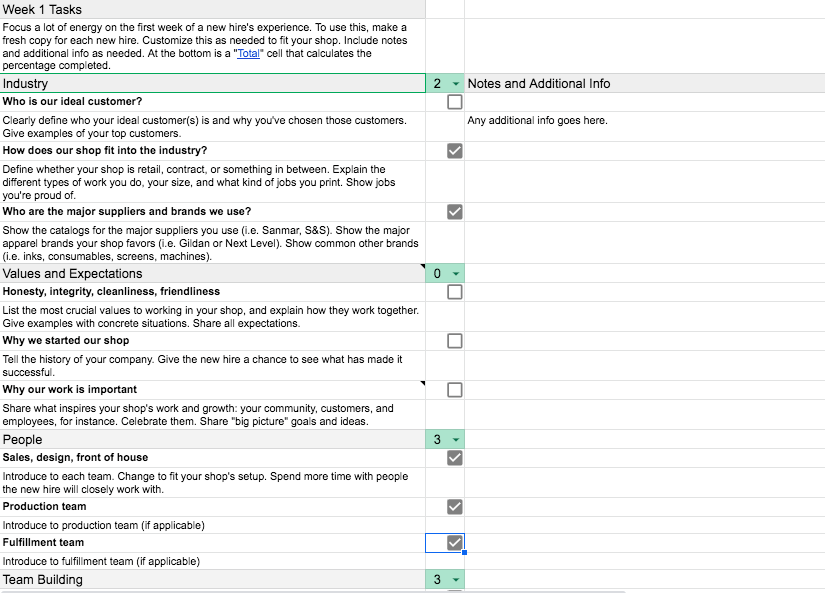
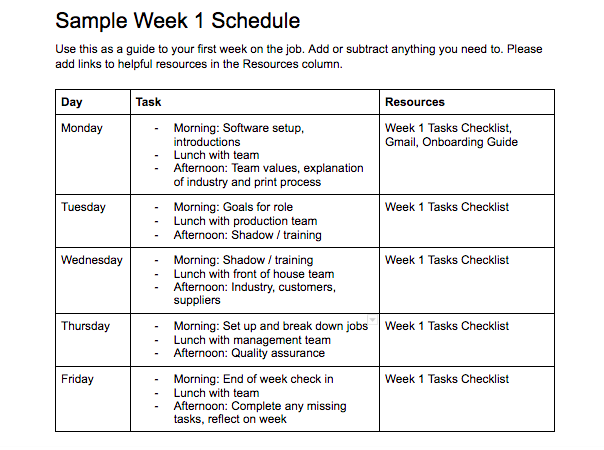
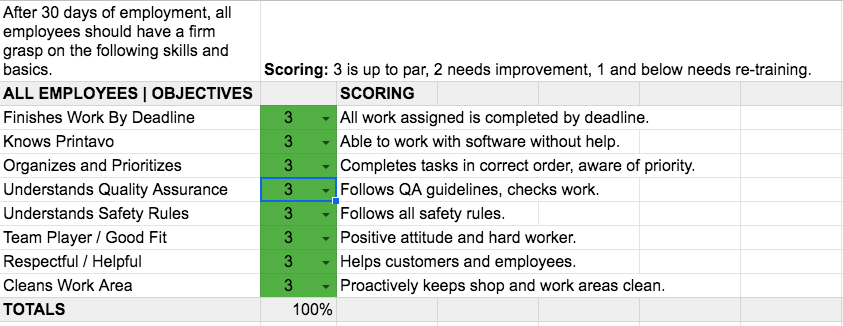
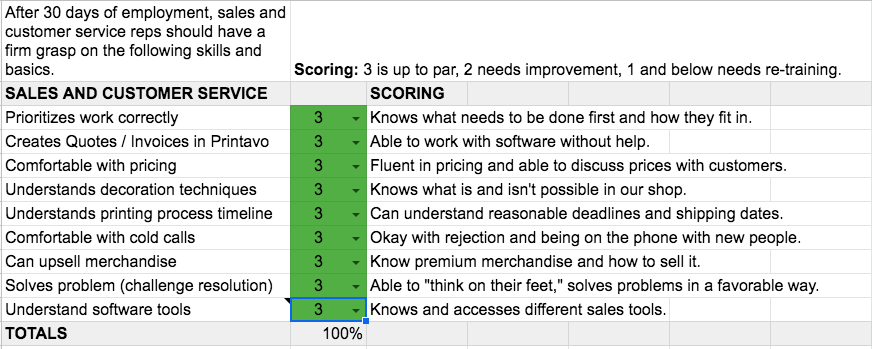

0 Comments